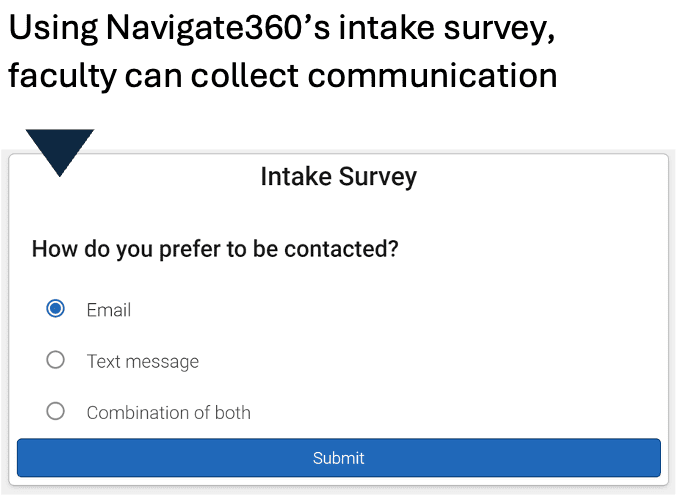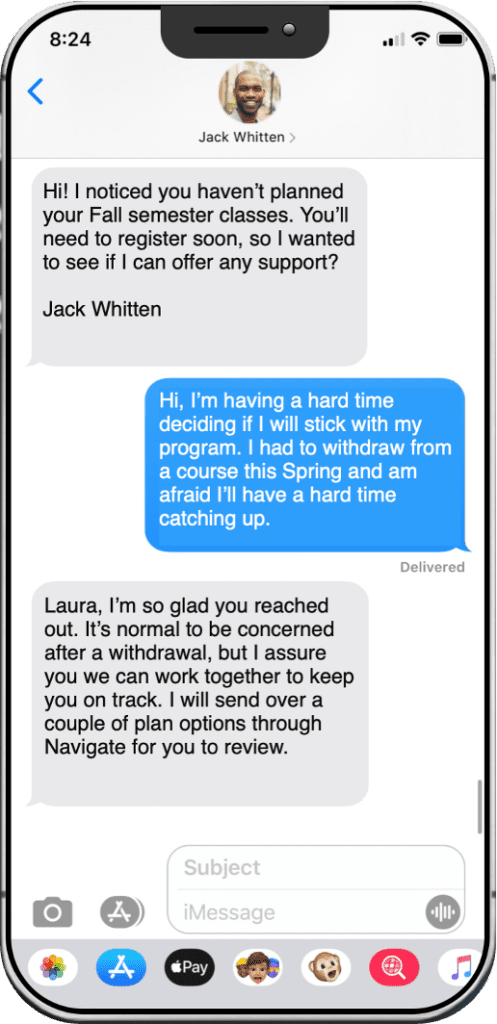Boost student engagement with data and easy-to-use technology
As a Student Success Strategic Leader at EAB, I’ve worked with dozens of partners of all shapes and sizes to meet their unique goals, but one common focus is the desire to improve student engagement. They recognize that engaged students are more likely to persist, but many institutions struggle with finding effective ways to foster meaningful engagement. Continue reading for my recommendations, based on my experience working with these schools, to help you create stronger connections with your students and improve their overall success.
Understand who you’re talking to
A great starting point for understanding your students’ needs is analyzing the data you already have—admissions, financial aid, residence life, and LMS data can all provide a strong foundation. However, the best way to truly understand what your students want is to ask them directly. Regularly surveying students throughout the year provides real-time insights into the resources and support they find most valuable, allowing you to deploy interventions more quickly. These pulse checks help you stay proactive and adjust your strategies based on their feedback.
When designing these surveys, take a help-focused approach with positive phrasing that encourages students to seek out resources. Be intentional about when you ask—whether it’s at the beginning of the semester or during high-stress times like exams—and make sure each survey has a clear goal and actionable steps based on the responses you receive.
Quick Polls
| Poll Question | Timing | Goal | Action Step |
|---|---|---|---|
| How are classes going so far? | Two weeks after the start of classes | Provide resources for students who feel overwhelmed or concerned | Automate an email to struggling students on how to schedule a tutoring appointment |
| What activities or organizations would you like to learn more about? | A few weeks into the semester | Identify students early on who need additional help finding their place on campus | Invite students to a campus-wide “get involved” event or activity fair |
| How are you feeling about your declared major? | Mid-semester | Provide support to students who may want to switch majors early, thereby preventing a delay in graduation or transfer risk | Automatically add students who may want to change majors to an advising appointment campaign |
| Have you completed the FAFSA? | Months or weeks leading up to FAFSA filing deadline | Proactively identify and reach out to students who may be at risk of not returning to school | Referral students who may need hands-on help to complete the FAFSA to the financial aid office |
I’ve seen partners like Arapahoe Community College (ACC) use quick polls as a connection point to ensure students have the basic tools they need to complete coursework—like access to a computer and reliable Internet—and gauge students’ plans for the upcoming semester. To ensure students’ challenges and needs are acted on, Navigate360 sends for students in need of support so care team members can intervene.
Meet students where they are
Engaging students effectively means connecting with them on platforms they already use, such as texting, student apps, or social media. By meeting students on these familiar channels, you can ensure your communications are seen and acted upon in real time. Students are constantly connected to their phones, checking messages, notifications, and apps throughout the day. Sending important updates through these channels—whether it’s a reminder to register for classes, a quick poll to check on their well-being, or an announcement about campus resources—makes it easier for students to stay informed and engaged with campus life.
 Multimodal communications
Multimodal communications
Using Navigate360
- Maintain two-way conversations with individual students at scale
- Unlimited text messaging, email, and mobile push notifications
- Supports text messages with up to 320 characters

Ensure engagement is a two-way street
Self-alerts, also known as Hand-raise alerts, make it easy for students to reach out for help whenever they need it. Since these alerts can be submitted on their terms, students don’t have to wait for office hours or a scheduled meeting to ask for assistance. This flexibility is especially important for the growing number of students who are juggling school, work, and other personal responsibilities.
Additionally, allowing students to self-alert gives them more control over their learning experience. When they know they can ask for help on their terms, they’re more willing to engage with support services. This proactive approach helps schools identify and assist students before small problems grow into bigger obstacles. By making it easy and empowering for students to reach out, institutions keep students engaged throughout their journey.
Hand-raise alerts
Students submit Hand-raises using the Navigate360 mobile app for a variety of reasons, including everything from academics (e.g. “I need help in a class”) to seeking mental health resources on campus (e.g. “I’m feeling overwhelmed”). Rather than being specifically timed like Quick Polls, Hand-raises should be available for students year-round. We never know when they might be willing to ask for help with a particular aspect of their college career or life.
Here are some best practices to keep in mind about Hand-raises:
- Be prepared to respond to these self-alerts quickly and efficiently.
- Use student-friendly language and avoid institutional jargon. Be positive and solution-focused.
- Provide some form of outreach to the student, either through automated or manual communication, to make sure that they know their request has been heard.
- Promote this tool on campus!
More examples of Hand-raise choices are:
- “I need help paying for college”
- “I need resources for childcare”
- “I need someone to review my academic plan”
- “I want to talk to someone about changing my major”
- “I need help with basic needs (food, housing, etc.)”
Technology allows for scaled support
Engaging students early with technology tools such as Quick Polls and Hand-raises in Navigate360, EAB’s student success CRM, opens the communication pipeline between students and staff. When students receive resources proactively in this way, it builds trust and confidence that they’ll get the support they need during their time at your institution. Offering easy ways for students to ask for help and providing students with what they need in a timely manner teaches them digital literacy and help-seeking behaviors that will benefit them throughout their lives.
More Blogs

Four signs it’s time to break up with your student CRM

Three lessons from 1,200 student success leaders on higher ed’s future

 Multimodal communications
Multimodal communications